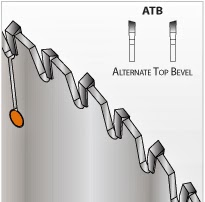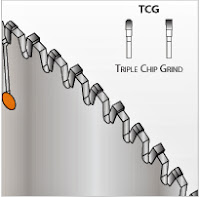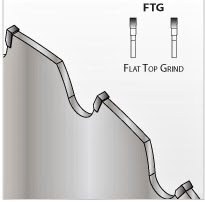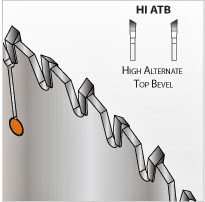 Loading... Please wait...
Loading... Please wait...Quick Guide to Choosing the Correct Saw Blade for Wood Cutting!
Posted by Patrick on 8th May 2014
Wood Saw Blade Basics - Your Quick Guide to Choosing the Correct Saw Blade for Wood Cutting!
Saw blades come in a wide variety of types, shapes, and sizes. Choosing the correct blade for your application can sometimes prove to be a daunting task. In this blog I will outline some topics to consider when trying to select a blade that is right for you.
Purpose & Material:
What type of wood are you cutting? When cutting wood will you be ripping (cutting with the grain) or cross-cutting (cutting across the grain)? At Panther Industrial we feature Oshlun Professional Saw Blades for general purpose, ripping, finishing, combination cuts, melamine & laminate, and demolition blades.
- General Purpose Blades have been designed for quick, clean cutting.
They are ideal for cutting all types of hardwood, softwood, and
plywood. The thin kerf of these blades allows for extended battery
life with cordless machines. Great for both cross cutting and ripping.
- Ripping:
Rip blades have been designed for ripping woods on table and radial arm
saws. They feature low tooth counts, large gullets, and aggressive
hook angles making them ideal for fast ripping applications.
- Fast Cutting / Trimming: Designed to quickly cut all types of hardwood, softwood
and plywood. These blades feature an anti-kickback tooth design;
with their thin kerf and aggresive hook angle these blades allow for
faster and easier cutting.
- Finishing / Framing: These blades are designed for the cleanest cutting
action. The higher tooth count allows for a fine and smooth cut on
cross cutting applications.
- Combination:
Great for both ripping and cross-cutting these blades have a 4 & 1
tooth grind. They feature 4 alternate top bevel teeth and 1 flat top
raker, this design adds more stability during the cut and helps clean and
and eject chips.
- Melamine / Laminate:
Designed with a negative hook angle these blades produce a very smooth,
chip-free cut in both single and double sided melamine, laminates and
veneers.
- Demolition Blades:
These blades feature a reinforced shoulder design, heavy duty steel plate,
negative hook angle and fracture resistant carbide tips. These features allow this blade to
easily cut through building materials such as roofing, shingles, and wood
with embedded nails.
Diameter and Arbor Size:
There are many different type of tools that can use a wood cutting saw blade such as circular saw, table saw, radial arm saw, chop saw, miter saw. You will need to find a blade with an arbor to fit your desired tool. common arbor sizes include 5/8" , 7/8", 1", 10mm, and 20mm. Many of our saw blades come with bushings, which can reduce the arbor of the blade.
Diameter size of the tool using is also an important thing to consider while choosing a blade. Panther Industrial's premium wood blades range from 5-3/8" to 16" diameter.
Tooth Count:
- Higher tooth count: great for finishing work and on thinner materials. The higher tooth count provides a smoother finish; however, having more teeth increases friction which could potentially could result in burning/melting of the product you are cutting.
- Lower tooth count: great for faster feeding of materials. This faster cut can potentially leave more burr marks which would not be ideal on finishing work.
Tooth Configuration:
- Alternate Top Bevel (ATB): The most common tooth configuration for saw blades. This design is suitable for both cross-cutting and ripping applications. Typically used on general purpose and finishing blades.
- Triple Chip Grind (TCG): This tooth configuration provides a balanced cutting force, it has the best wear resistance, and it provides good chip flow. This design is typically used for cutting metals, plastic, and solid surface materials.
- Flat Top Grind (FTG): Cuts on both sides of the of the kerf at the same time. Twice as effective as ATB for fast cutting. The balanced cutting reduces stress on the plate. This design is typically used for ripping and specialty blades.
- 4 ATB & 1 FTG (4 & 1): This blade design features 4 Alternate Bevel teeth followed by 1 Flat Top raker tooth that is then followed by a large gullet. This configuration helps add stability during cutting and the large gullet helps clean out and eject chips. Typically used on Combination Blades.
- High Alternate Top Bevel (Hi-ATB): This is a similar design to standard ATB blades, but with a more acute top bevel grind with longer teeth. This design provides extra fine cuts in man made materials. This is typically used in plastic, melamine and laminate cutting blades.
Gullet:
Gullet space refers to the trough between the teeth on a saw blade. With a larger gullet space, the blade can eject more chips resulting in faster cuts. Higher tooth blades often leave less spacing between teeth resulting in small gullet space.
Hook Angle:
Hook angle also known as rake angle is the angle a tooth leans in relation to the center of the saw blade. Positive rake leans forward and is great for faster cutting. Positive rake is desirable for ripping applications. One must be careful with Blades that have a positive rake, because they have a tendency to pull the material. Positive rake is ideal on table saws.
Negative rake leans back in relation to the center of the blade, these style blades require more feed pressure. Negative rake is ideal on miter and radial arm saws.
Kerf:
Kerf refers to the width of a cut that the saw blade leaves as it cuts through the material. With recent developments in saw blade technology, saw manufacturers are keeping the level of strength and longevity of saw blades with thinner kerfs. Ultra thin kerf blades are ideal on cordless portable saws because the thinner blade requires less power to cut through material, which extends the life of the battery on your power tool.
At PantherIndustrial.com we stock a wide variety of Metal Cutting (Ferrous/Non-Ferrous), Wood Cutting, Plastic Cutting, and Specialty Blades!
The helpful staff at Panther Industrial would love to answer any questions and assist you in finding the perfect blade! Please call (888) 857-0165 or stop by our site today www.pantherindustrial.com !







